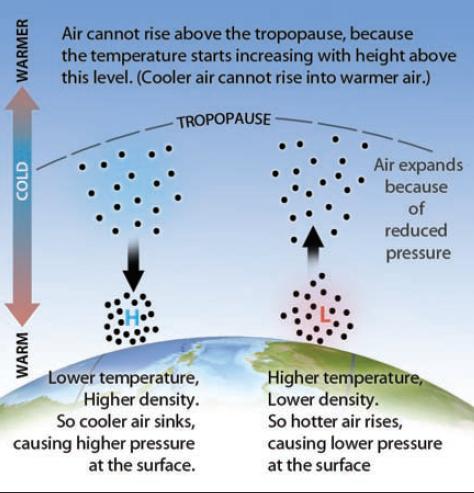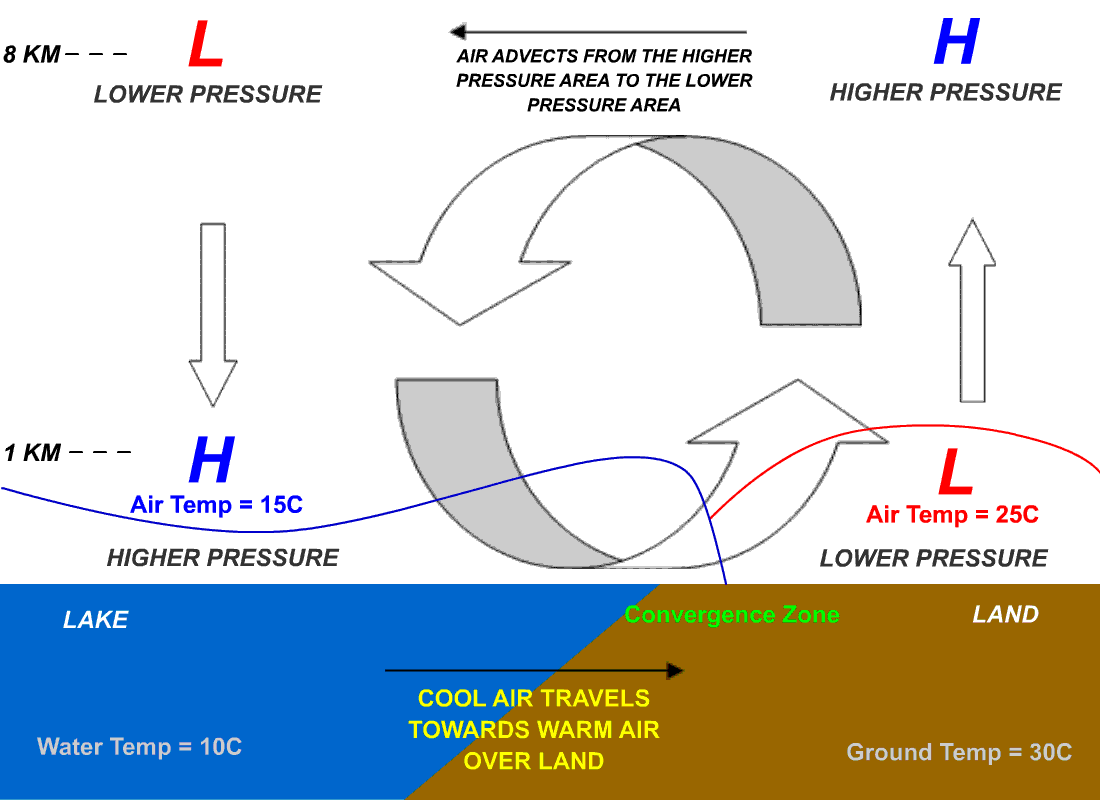Explain How Differences in Air Pressure Cause Winds to Form
This thermal energy from the Sun is transformed into kinetic energy carrying air masses from one region of the planet to another. The wind chill factor is a temperature that represents the feels like temperature of wind on exposed skin in terms of an equivalent temperature in calm conditions.
As the air rises the water vapor within it condenses forming clouds and often precipitation.

. Specifically differences in pressure across the globe result in a force called the pressure gradient force that sets air in motion. Lows are usually associated with high winds warm air and atmospheric lifting. Wind results from a horizontal difference in air pressure and since the sun heats different parts of the Earth differently causing pressure differences the Sun is the driving force for most winds.
Clouds and precipitate are formed. Cool air sinks creating a high pressure zone. In other words what causes the wind to blow.
The speed of wind is also determined by a deflection of winds straight pattern along the earths surface known as the Coriolis effect. That rush of air is the wind we. Wind forms when the sun heats one part of the atmosphere differently than another part.
That is to say the different heating that the. This is called cyclonic flow. During the day at a coast the sun heats the air above the land more quickly than the.
15 What causes temperature difference. As air moves gradually from one pressure gradient to another light winds are created. 12 What causes wind quizlet.
14 Which two factors below affect air pressure. Air masses tend to flow from areas of high air pressure to areas of low air pressure. Air that moves quickly from one pressure gradient to another creates fast or strong winds.
The greater the pressure difference between the pressure zones the faster the wind moves. Wind exists because of horizontal and vertical differences gradients in pressure yielding a correspondence that often makes it possible to use the pressure distribution as an alternative representation of atmospheric motions. Wind is air in motion.
The process that creates wind is the following. Changes in air pressure also determine the speed of wind. The Short Answer.
Typically air under high pressure normally moves towards areas under low pressure. The wind is a result of forces acting on the atmosphere. 18 Are an effect of the difference in air.
When a difference in pressure exists the air is accelerated from higher to. As a result air rises and cools. Under these conditions lows normally produce clouds precipitation and other turbulent weather such as.
Rising air creates low pressure while sinking air creates high pressure. And the bigger the difference between the pressures the faster the air will move from the high to the low pressure. As you might have guessed since weve been discussing atmospheric pressure the reason that air moves horizontally is related to pressure.
Air always moves from high pressure to lower pressure and this movement of air is wind. In fact wind is Mother Natures way of equalizing differences in air pressure. Winds blow towards the low pressure and the air rises in the atmosphere where they meet.
16 What is the cause of difference in density of air. With high pressure sinking air suppresses weather development. Differences in air pressure can result in the movement of air masses from one location to another.
A low-pressure system also called a depression is an area where the atmospheric pressure is lower than that of the area surrounding it. The wind chill effect arises because as wind blows over the skin it evaporates moisture leading to a cooling effect. Wind is caused by differences in pressure.
Air that moves horizontally between high and low pressure zones makes wind. 13 What causes wind chill quizlet. High air pressure produces clear sky dry and stable weather.
Thus winds blow away from high-pressure areas. This is why air currents for each pressure belt do not go directly north or south but northeast and southeast or southwest. Wind can be defined as air currents or moving mass of air from high pressure areas to low pressure areas.
Pressure Gradient Force PGF - causes horizontal pressure differences and winds 2. Thats why most of the air will leave a balloon whenever it gets a hole. The closer the high and low pressure areas are together the stronger the pressure gradient so the winds are stronger.
In a low pressure zone wind is circulated inwards and upwards rapidly. Warm air rises creating a low pressure zone. Remember that air does not flow directly from high pressure to low pressure but is deflected due to the _____ _____.
Convection in the atmosphere creates the planets weather. Winds in each pressure belt also have a name. Thus the greater the pressure difference the faster the flow of air which creates moving air with considerably strong force.
Air pressure is the force that air exerts toward whatever contains it. 11 What causes differences in air pressure Brainly. Because of Earths spin and the Coriolis effect winds of a low pressure system swirl counterclockwise north of the equator and clockwise south of the equator.
Although these two physical variables may at first glance appear to be quite different they are in fact closely related. 17 What causes atmospheric circulation. This causes expansion of warmer air making less pressure where it is warm than where it is cooler.
Wind blows towards low-pressure areas. The pressure of air in a balloon is higher than that of the air outside. When it comes to the atmosphere air pressure.
Solar radiation generates temperature differences in the atmosphere which gives rise to pressure differences and air movement. Gases move from high-pressure areas to low-pressure areas. Air masses also move vertically.

Comments
Post a Comment